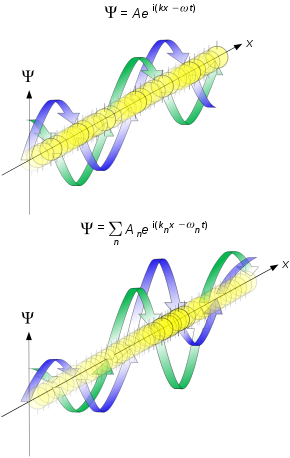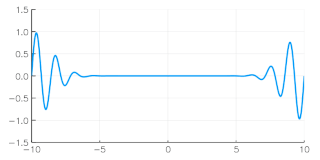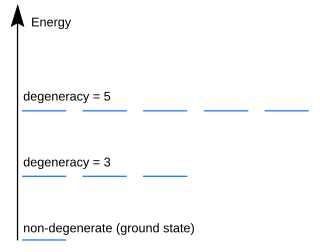Classical free particle
The classical free particle is characterized by a fixed velocity v. The momentum is given by
and the kinetic energy (equal to total energy) by
where m is the mass of the particle and v is the vector velocity of the particle.
In physics, a free particle is a particle that, in some sense, is not bound by an external force, or equivalently not in a region where its potential energy varies. In classical physics, this means the particle is present in a "field-free" space. In quantum mechanics, it means the particle is in a region of uniform potential, usually set to zero in the region of interest since the potential can be arbitrarily set to zero at any point in space.
The classical free particle is characterized by a fixed velocity v. The momentum is given by
and the kinetic energy (equal to total energy) by
where m is the mass of the particle and v is the vector velocity of the particle.

A free particle with mass in non-relativistic quantum mechanics is described by the free Schrödinger equation:
where ψ is the wavefunction of the particle at position r and time t. The solution for a particle with momentum p or wave vector k, at angular frequency ω or energy E, is given by a complex plane wave:
with amplitude A and has two different rules according to its mass:
The eigenvalue spectrum is infinitely degenerate since for each eigenvalue E>0, there corresponds an infinite number of eigenfunctions corresponding to different directions of .
The De Broglie relations: , apply. Since the potential energy is (stated to be) zero, the total energy E is equal to the kinetic energy, which has the same form as in classical physics:
As for all quantum particles free or bound, the Heisenberg uncertainty principles apply. It is clear that since the plane wave has definite momentum (definite energy), the probability of finding the particle's location is uniform and negligible all over the space. In other words, the wave function is not normalizable in a Euclidean space, these stationary states can not correspond to physical realizable states. [1]
The integral of the probability density function
where * denotes complex conjugate, over all space is the probability of finding the particle in all space, which must be unity if the particle exists:
This is the normalization condition for the wave function. The wavefunction is not normalizable for a plane wave, but is for a wave packet.
The free particle wave function may be represented by a superposition of momentum eigenfunctions, with coefficients given by the Fourier transform of the initial wavefunction: [2]
where the integral is over all k-space and (to ensure that the wave packet is a solution of the free particle Schrödinger equation). Here is the value of the wave function at time 0 and is the Fourier transform of . (The Fourier transform is essentially the momentum wave function of the position wave function , but written as a function of rather than .)
The expectation value of the momentum p for the complex plane wave is
and for the general wave packet it is
The expectation value of the energy E is

The phase velocity is defined to be the speed at which a plane wave solution propagates, namely
Note that is not the speed of a classical particle with momentum ; rather, it is half of the classical velocity.
Meanwhile, suppose that the initial wave function is a wave packet whose Fourier transform is concentrated near a particular wave vector . Then the group velocity of the plane wave is defined as
which agrees with the formula for the classical velocity of the particle. The group velocity is the (approximate) speed at which the whole wave packet propagates, while the phase velocity is the speed at which the individual peaks in the wave packet move. [3] The figure illustrates this phenomenon, with the individual peaks within the wave packet propagating at half the speed of the overall packet.
The notion of group velocity is based on a linear approximation to the dispersion relation near a particular value of . [4] In this approximation, the amplitude of the wave packet moves at a velocity equal to the group velocity without changing shape. This result is an approximation that fails to capture certain interesting aspects of the evolution a free quantum particle. Notably, the width of the wave packet, as measured by the uncertainty in the position, grows linearly in time for large times. This phenomenon is called the spread of the wave packet for a free particle.
Specifically, it is not difficult to compute an exact formula for the uncertainty as a function of time, where is the position operator. Working in one spatial dimension for simplicity, we have: [5]
where is the time-zero wave function. The expression in parentheses in the second term on the right-hand side is the quantum covariance of and .
Thus, for large positive times, the uncertainty in grows linearly, with the coefficient of equal to . If the momentum of the initial wave function is highly localized, the wave packet will spread slowly and the group-velocity approximation will remain good for a long time. Intuitively, this result says that if the initial wave function has a very sharply defined momentum, then the particle has a sharply defined velocity and will (to good approximation) propagate at this velocity for a long time.
There are a number of equations describing relativistic particles: see relativistic wave equations.
In quantum mechanics, the Hamiltonian of a system is an operator corresponding to the total energy of that system, including both kinetic energy and potential energy. Its spectrum, the system's energy spectrum or its set of energy eigenvalues, is the set of possible outcomes obtainable from a measurement of the system's total energy. Due to its close relation to the energy spectrum and time-evolution of a system, it is of fundamental importance in most formulations of quantum theory.

In quantum mechanics, the particle in a box model describes the movement of a free particle in a small space surrounded by impenetrable barriers. The model is mainly used as a hypothetical example to illustrate the differences between classical and quantum systems. In classical systems, for example, a particle trapped inside a large box can move at any speed within the box and it is no more likely to be found at one position than another. However, when the well becomes very narrow, quantum effects become important. The particle may only occupy certain positive energy levels. Likewise, it can never have zero energy, meaning that the particle can never "sit still". Additionally, it is more likely to be found at certain positions than at others, depending on its energy level. The particle may never be detected at certain positions, known as spatial nodes.

The uncertainty principle, also known as Heisenberg's indeterminacy principle, is a fundamental concept in quantum mechanics. It states that there is a limit to the precision with which certain pairs of physical properties, such as position and momentum, can be simultaneously known. In other words, the more accurately one property is measured, the less accurately the other property can be known.

The quantum harmonic oscillator is the quantum-mechanical analog of the classical harmonic oscillator. Because an arbitrary smooth potential can usually be approximated as a harmonic potential at the vicinity of a stable equilibrium point, it is one of the most important model systems in quantum mechanics. Furthermore, it is one of the few quantum-mechanical systems for which an exact, analytical solution is known.

The Schrödinger equation is a linear partial differential equation that governs the wave function of a quantum-mechanical system. Its discovery was a significant landmark in the development of quantum mechanics. It is named after Erwin Schrödinger, who postulated the equation in 1925 and published it in 1926, forming the basis for the work that resulted in his Nobel Prize in Physics in 1933.

In quantum physics, a wave function is a mathematical description of the quantum state of an isolated quantum system. The most common symbols for a wave function are the Greek letters ψ and Ψ. Wave functions are complex-valued. For example, a wave function might assign a complex number to each point in a region of space. The Born rule provides the means to turn these complex probability amplitudes into actual probabilities. In one common form, it says that the squared modulus of a wave function that depends upon position is the probability density of measuring a particle as being at a given place. The integral of a wavefunction's squared modulus over all the system's degrees of freedom must be equal to 1, a condition called normalization. Since the wave function is complex-valued, only its relative phase and relative magnitude can be measured; its value does not, in isolation, tell anything about the magnitudes or directions of measurable observables. One has to apply quantum operators, whose eigenvalues correspond to sets of possible results of measurements, to the wave function ψ and calculate the statistical distributions for measurable quantities.

In physics, a wave packet is a short burst of localized wave action that travels as a unit, outlined by an envelope. A wave packet can be analyzed into, or can be synthesized from, a potentially-infinite set of component sinusoidal waves of different wavenumbers, with phases and amplitudes such that they interfere constructively only over a small region of space, and destructively elsewhere. Any signal of a limited width in time or space requires many frequency components around a center frequency within a bandwidth inversely proportional to that width; even a gaussian function is considered a wave packet because its Fourier transform is a "packet" of waves of frequencies clustered around a central frequency. Each component wave function, and hence the wave packet, are solutions of a wave equation. Depending on the wave equation, the wave packet's profile may remain constant or it may change while propagating.

In physics, the Rabi cycle is the cyclic behaviour of a two-level quantum system in the presence of an oscillatory driving field. A great variety of physical processes belonging to the areas of quantum computing, condensed matter, atomic and molecular physics, and nuclear and particle physics can be conveniently studied in terms of two-level quantum mechanical systems, and exhibit Rabi flopping when coupled to an optical driving field. The effect is important in quantum optics, magnetic resonance and quantum computing, and is named after Isidor Isaac Rabi.
In physics, the S-matrix or scattering matrix relates the initial state and the final state of a physical system undergoing a scattering process. It is used in quantum mechanics, scattering theory and quantum field theory (QFT).
Creation operators and annihilation operators are mathematical operators that have widespread applications in quantum mechanics, notably in the study of quantum harmonic oscillators and many-particle systems. An annihilation operator lowers the number of particles in a given state by one. A creation operator increases the number of particles in a given state by one, and it is the adjoint of the annihilation operator. In many subfields of physics and chemistry, the use of these operators instead of wavefunctions is known as second quantization. They were introduced by Paul Dirac.
In quantum physics, Fermi's golden rule is a formula that describes the transition rate from one energy eigenstate of a quantum system to a group of energy eigenstates in a continuum, as a result of a weak perturbation. This transition rate is effectively independent of time and is proportional to the strength of the coupling between the initial and final states of the system as well as the density of states. It is also applicable when the final state is discrete, i.e. it is not part of a continuum, if there is some decoherence in the process, like relaxation or collision of the atoms, or like noise in the perturbation, in which case the density of states is replaced by the reciprocal of the decoherence bandwidth.

In quantum mechanics, a two-state system is a quantum system that can exist in any quantum superposition of two independent quantum states. The Hilbert space describing such a system is two-dimensional. Therefore, a complete basis spanning the space will consist of two independent states. Any two-state system can also be seen as a qubit.

In quantum mechanics, an energy level is degenerate if it corresponds to two or more different measurable states of a quantum system. Conversely, two or more different states of a quantum mechanical system are said to be degenerate if they give the same value of energy upon measurement. The number of different states corresponding to a particular energy level is known as the degree of degeneracy of the level. It is represented mathematically by the Hamiltonian for the system having more than one linearly independent eigenstate with the same energy eigenvalue. When this is the case, energy alone is not enough to characterize what state the system is in, and other quantum numbers are needed to characterize the exact state when distinction is desired. In classical mechanics, this can be understood in terms of different possible trajectories corresponding to the same energy.
In quantum mechanics, the probability current is a mathematical quantity describing the flow of probability. Specifically, if one thinks of probability as a heterogeneous fluid, then the probability current is the rate of flow of this fluid. It is a real vector that changes with space and time. Probability currents are analogous to mass currents in hydrodynamics and electric currents in electromagnetism. As in those fields, the probability current is related to the probability density function via a continuity equation. The probability current is invariant under gauge transformation.
Photon polarization is the quantum mechanical description of the classical polarized sinusoidal plane electromagnetic wave. An individual photon can be described as having right or left circular polarization, or a superposition of the two. Equivalently, a photon can be described as having horizontal or vertical linear polarization, or a superposition of the two.
The theoretical and experimental justification for the Schrödinger equation motivates the discovery of the Schrödinger equation, the equation that describes the dynamics of nonrelativistic particles. The motivation uses photons, which are relativistic particles with dynamics described by Maxwell's equations, as an analogue for all types of particles.
The Gross–Pitaevskii equation describes the ground state of a quantum system of identical bosons using the Hartree–Fock approximation and the pseudopotential interaction model.

The transition dipole moment or transition moment, usually denoted for a transition between an initial state, , and a final state, , is the electric dipole moment associated with the transition between the two states. In general the transition dipole moment is a complex vector quantity that includes the phase factors associated with the two states. Its direction gives the polarization of the transition, which determines how the system will interact with an electromagnetic wave of a given polarization, while the square of the magnitude gives the strength of the interaction due to the distribution of charge within the system. The SI unit of the transition dipole moment is the Coulomb-meter (Cm); a more conveniently sized unit is the Debye (D).
In quantum mechanics, energy is defined in terms of the energy operator, acting on the wave function of the system as a consequence of time translation symmetry.
This is a glossary for the terminology often encountered in undergraduate quantum mechanics courses.